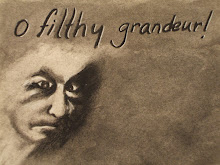Well, believe it. I enjoyed watching KCA (I couldn't watch it live since I'm a grown-up who has to work nights sometimes, so I watched the replay this morning). Anyway, I thought it was all cute and fun, like it always is, and Dwayne Johnson was a fun host. Less than twenty-four hours of it airing, however, the stars get graded on their attire, and after clicking through only the first few images, it's clear what the judges think of women. Take the quote on the first photo with Zac Efron and Venessa Hudgens:
Since Zac just got back from promoting his new film, "17 Again," in Europe, we're assuming jet lag is the reason he allowed his girlfriend out of the house in this getup.Yeah, it's all his fault she's dressed the way he is. How dare he not assert his dominance over her person by telling her what she can and cannot wear in public?
It gets worse. The second pic is one of Hudgens alone, with this nice critique:
Did the "High School Musical" sweetheart realize she was at the Kids' Choice AwFirst of all, it's a kids' award show, which means you don't have to impress stodgy adults. Maybe it's just me, but I know I wouldn't dress too fancy at an awards show known for its random sliming (here's my exuse for posting a picture of Johnny Depp--note this was not from 2009).ards, or did she think she was auditioning for the Pussycat Dolls?
To even out the sexism by the fashion nazis, the Jonas Brothers are also critiqued for wearing "man scarves!" OMG NOOO!
I really got pissed when I read the comment about America Ferrara's dress:
Unfortunately, America Ferrera's pink chiffon dress made her look more like a mom than the hot young star that she is!Really?? So, what you're telling me is that someone can't be a young hot mom? Or a young hot mom star? What this says is that once you're a mom, you become not as attractive, and since looks are all that matters in this damn society, mom's (who are apparently automatically not sexy) are not valued. This also equates being a mom with being old--there are plenty of moms who are the same age as Ferrera. And while I"m at it, what's so wrong with a woman wanting to look older? So congrats Yahoo's OMG!: you've successfully managed to be sexist and ageist in one sentence!
And while we're being ageist:
Although she's pushing 37, Cameron Diaz proved she can rock a pair of skinny shredded jeans as well as a teenager can!There's not one mention of a male celebrity's age. In the one instance where a man's appearance makes him look older, he is praised for it:
Corbin Bleu appeared to have grown up overnight thanks to his tamed curls and trendy suit.So, shame on you Ferrera, good for you Bleu. And I don't think it's much of a stretch to point out how when a man looks older, he's not accused of looking like a dad. Which shows you how ageism and sexism are linked. And while I'm at it, I think there's some racism in the word "tamed." There was absolutely nothing wrong with his hair before. This just goes back to how people value straight hair in POC because it equates with professionalism, controlling hair to do something it doesn't naturally do. For men, wearing your hair natural makes you immature, and though his hair is still curly, Bleu's hair is now "tamed" and so it's better (for WOC this standard of hair care is worse).
Ugh, I can't go on. Apparently even an awards show for kids is not exempt from devaluing people based on what they've chosen to wear.




















